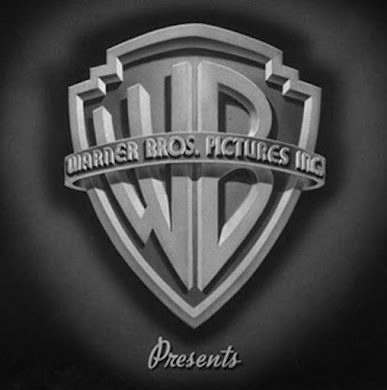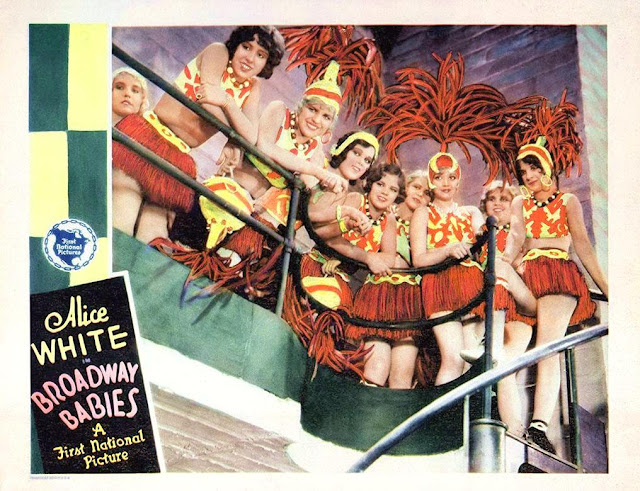The film starts and ends with a view through a wind shield lettered “Ambulance” and a siren on the track. We get to Barbara Stanwyck right in her element, as the on her uppers girl who didn’t make it through high school, rejected by Chief Nurse Vera Lewis despite her “I’m sure I can make good” entreaty. Easy to recognise the year and the studio.
When Babs (literally) bumps into respected doctor Charles Winninger on her way out, she is taken on for nurse training, sharing a room with gum chewing fellow trainee Blondell . “It’s the only job where they pay you while you learn.” The pair get down to their scanties to change into uniform at every possibility and don’t show any self consciousness.
They have to deal with grabby Interns Edward J. Nugent and Alan Lane pranking her with an anatomy class skeleton (weak scene), fierce curfews, a patient dying on Dr. Winniger’s table and dodgy situations like not putting walk-in bootlegger Ben Lyon’s bullet wound on the record after we've seen Cop Jim Farley guarding patient James Bradbury Jr. who has to be sent to the prison ward.
 |
| Night Nurse - Lyon, Blondell & Stanwyck |
On-ward visitor Lucille Ward asks why her son can’t have a screen like the patient next to them and is told that the screened one is dying. Willy Fung's wife is in one bed and the naked baby we see being washed (Stanwyck carefully framed out of shot tight on hands) is black. Blondell explains that doctors don’t date nurses and the interns see them as cut price receptionists. We recognise a try for Warner documentation.
The girls get to graduate, taking the nurses' oath in a chapel where Lyon’s floral display dwarfs the others.
Then we move to the Night Nurse plot proper where Stanwyck is put in to look after bottle blonde mother Charlotte Merriam’s two little girls Betty Jane Graham and Marcia Mae Jones in the charge of severe house keeper Blanche Friderici and dodgy doctor Ralf Harolde. Babs detects severe malnutrition. There’s an on going party with drunken Walter McGrail having to be punched out when be moves on her and Merriam (“I’m a dypsomaniac”) out of things.
Babs' objections are met by Nick the chaufeur (“a horrid man”) who shows up in the person of an imposing, clean shaven Clark Gable in shiny knee boots and drops Barbara - punch framed out of shot. Her approach to Harrold is met by threats of being thrown out of the profession and Winninger is reluctant to interfere, so she eats humble pie and waits for her opportunity.
 |
| Stanwyck with a horrid man. |
decks the old man but when he moves on Ben, our hero taps the hand in his coat pocket against the wall, to give a suitable hard contact thud (we've seen him use a pistol to smash a store window) and the day is saved.
No doubt about the attack and energy Wellman gives this one - characteristic low angle groups and sometimes awkward close two shot dialogues. The sleazy content is occasionally uncomfortable viewing nearly a Century later but it is one of the main things that makes this one enduring “Pre Code”.
We know about these American respectability baiting movies but there is a counterpart in Weimar Germany.
 |
| Margin information showing on title. |
Mixing documentary coverage and scenes of underclass life, like director Hochbaum's 1929 S.D.R. sponsored Brüder, his Razzia in St. Pauli starts with an OK montage of Hamburg Port activity, mixing nicely to dancing feet and carrying on through a ferry emptying passengers to fill the streets, we get to the port area with it’s bar girls and chop suey restaurants. There’s a disturbing cut to what looks like a small studio-interior guest house room where factory girl Gina Falckenberg has taken to her bed arguing with departing lover, balding Wolfgang Zilzer, while a street band disturbs the peace.
 |
| Razzia - Falkenberg |
Deciding the new comer is a more suitable partner, she takes him to Max Zilzer’s busy Reeperbahn corner bar. When her live-in boy friend shows up to play piano with the small band, there’s a confrontation between the two men which looks like it will turn ugly but ends as a drunken threesome.
 |
| Razzia - Zilzer, Falkenberg & Gnaß |
We get Falkenberg narrating her background in a rich family, played over scenes of her real poverty stricken childhood and drinker Charly Wittong is persuaded to do a song to general applause.
Meanwhile at Police Station 13 (small interior decors with cuts to a wall clock), Inspector Friedrich Rittmeyer mobilises the force to apprehend Gnaß. A suspicious stranger appears the the bar and is taken to be a police nark with the customers clearing away the furniture for a fight - clearly a familiar maneuver - but Gnaß recognises the man’s tattoo and hails him as a fellow underworld figure.
The cops do raid, headed by a bowler hat officer who looks like his counterpart in contemporary films like Blackmail or Spione with the customers dispersed and police wagons with lights blazing racing to the scene. Falkenberg finds herself left to fall back on the company of her old lover for the new day.
 |
| Busch in Die Dreigroschenoper. |
It is a symphony of a city montage movie like Walter Ruttman’s then recent Berlin: Die Sinfonie der Grosstadt, mixed in with elements of the Krimmi films (think German Edgar Wallace & Sherlock Holmes), shot largely in real surroundings and using genuine locals as extras (bad teeth seemed to be universal) giving a realistic account of Hamburg’s urban underbelly which immediately shows usual fiction film representations as fake.
This got up the nose of the new Nazi censorship and the film was forbidden as degenerate after a small number of showings, setting the scene for the prohibition of the more ambitious Dr. Mabuse film. It was also seen as a leftist preachment with Hochbaum’s background in the Volksverband für Filmkunst and Social Democratic party. Ernst Bush having been the street singer in the Brecht-Weil Die Dreigroschenoper stoked the fire.
The score is of particular interest. Dr. Giuseppe Becce had been head of music at UFA in the silent period and films of Lang, Murnau and Luis Trenker were first seen accompanied by his music. One of his pieces turns up in the intro to the Karloff Frankenstein. The music on Razzi in St. Pauli, which includes live filmed piano playing must be considered authentic. It sounds nothing like the imitation Kurt Weil, heavy on saxophones, which is usually played with scenes of thirties German low life.
Despite the fate of his first feature film, Werner Hochbaum had a sustained career during the thirties. Attractive & slim Gina Falckenberg was a departure from the stocky female leads then favored by German films, reflecting a diet high on dumplings and potatoes. She continued in secondary roles and rounded out her career writing movies scripts for twenty years. Husky Friedrich Gnaß might have been expected to have build a substantial tough guy filmography along the lines of Bogart and Charles Bronson but he was confined to support parts. The film did have some influence, notably on Ingrid Bergman’s first film Munkbrogreven.
Razzia in St. Pauli is not a great film. It has self conscious touches (a champagne cork pop butted onto a pistol shot, insets of the teddy bear falling on the doll to take the place of explicit footage) These conflict with the startling realism. Integrating the documentary material into its slight fiction plot undermines any narrative drive. It’s daring doesn’t run to nudity and violence. We have to do with drunkenness and promiscuity. However it is the most convincing account of thirties Weimar low life that movies achieved and that does make it startling and notable.
The Berlin Archive copy is sharp and tinted, with excellent English sub-titles. It has been reproduced with an open gate, admirably trying to accommodate the full frame height aperture but this means that the edge of the sound track and perforations appear distractingly on You Tube.
A murky copy of Hochbaum's 1936 Der Favorit der Kaiserin without sub-titles is also there. Like a number of German film makers, his career appears to have come to a halt in 1939.















